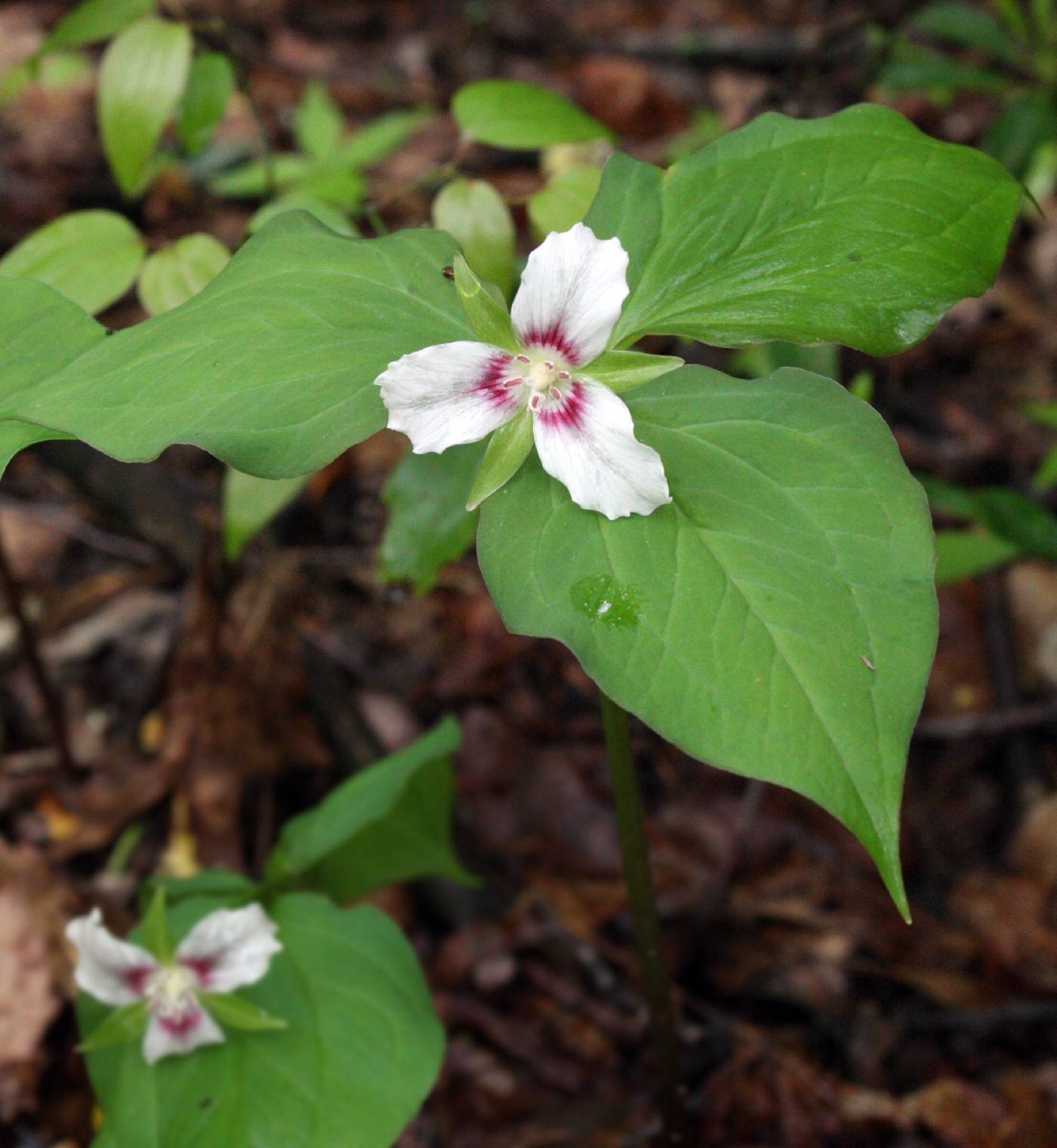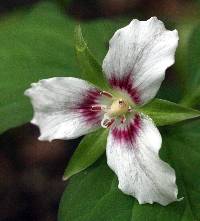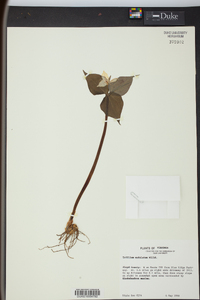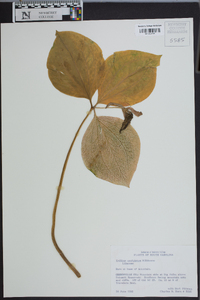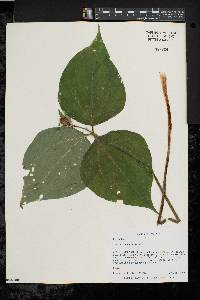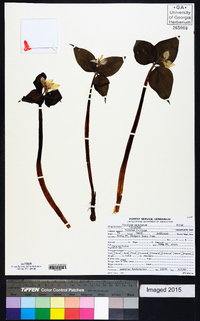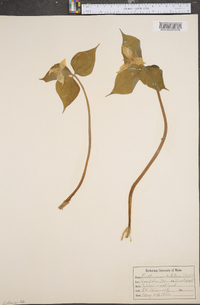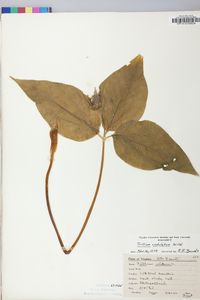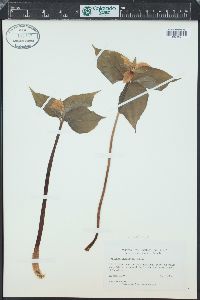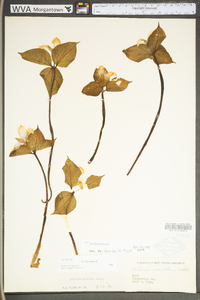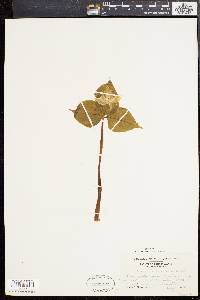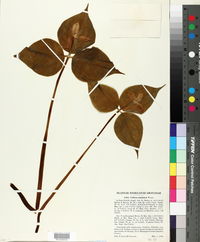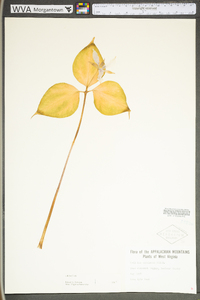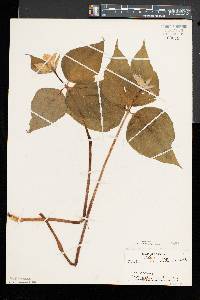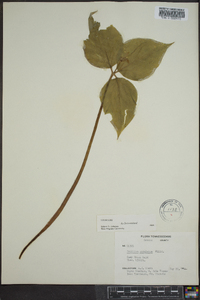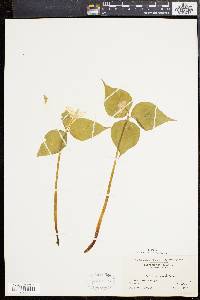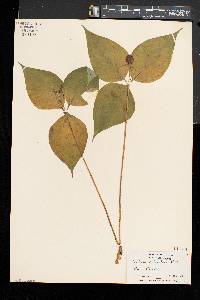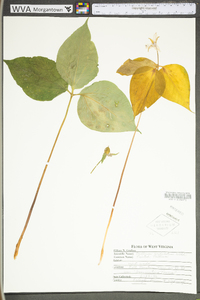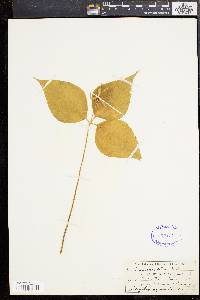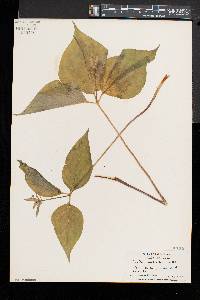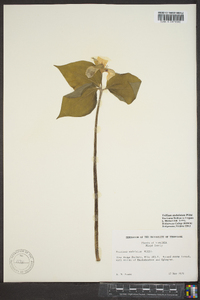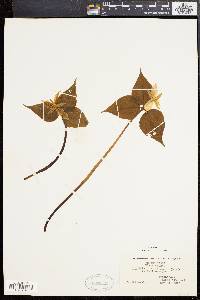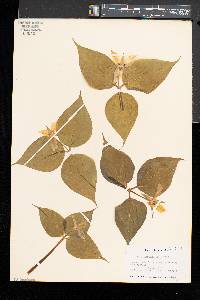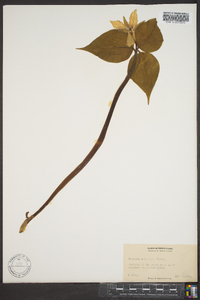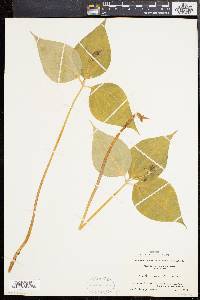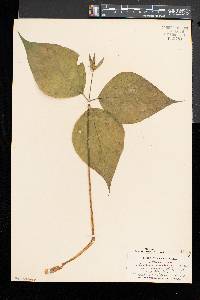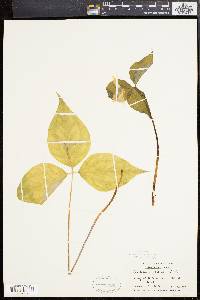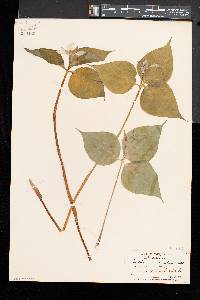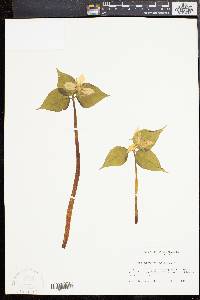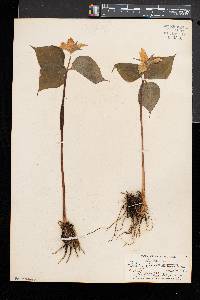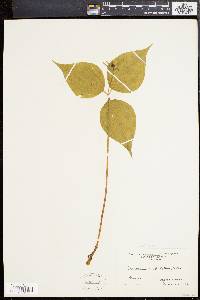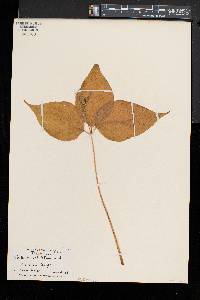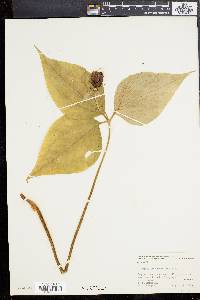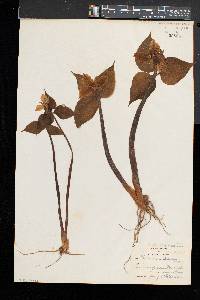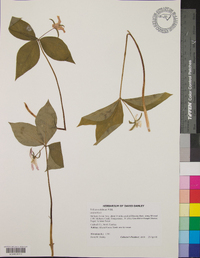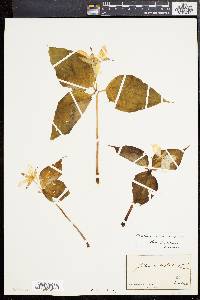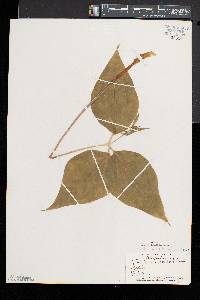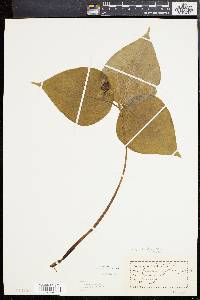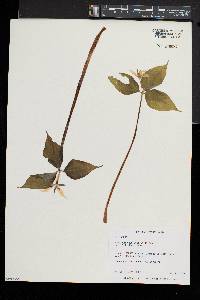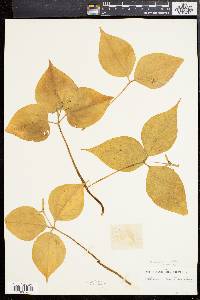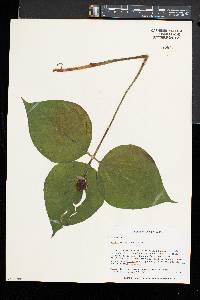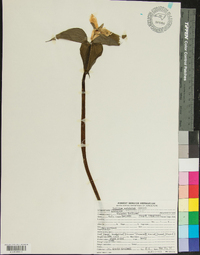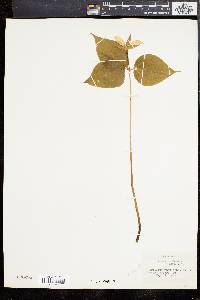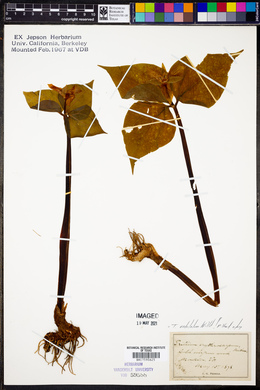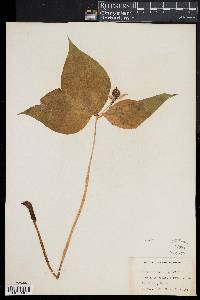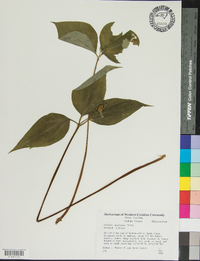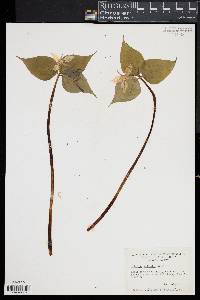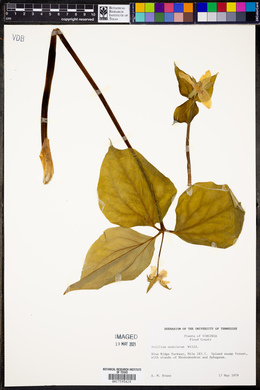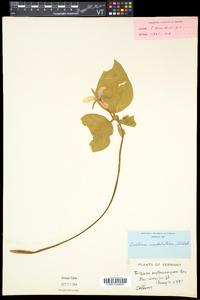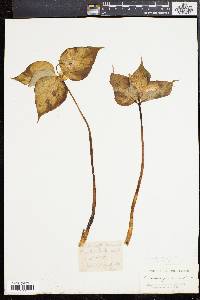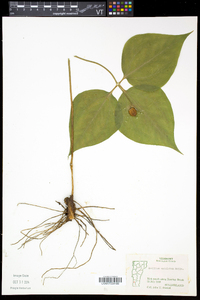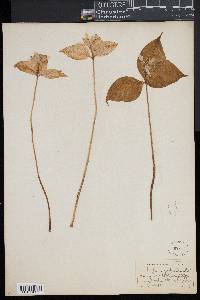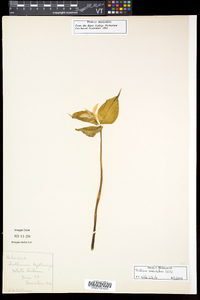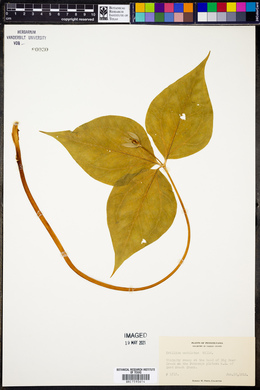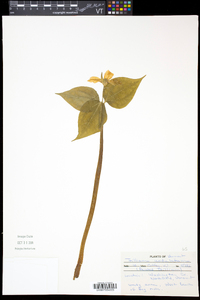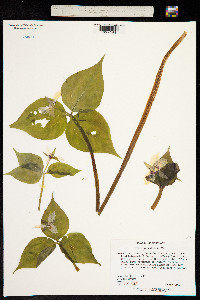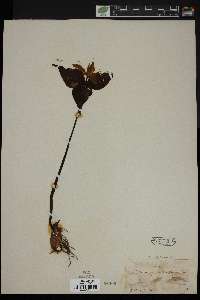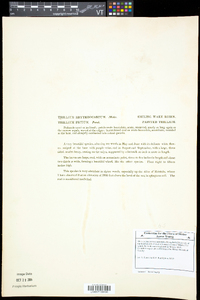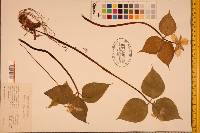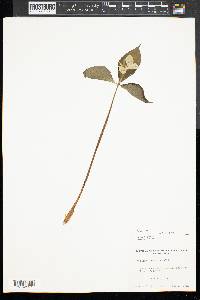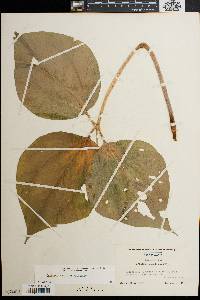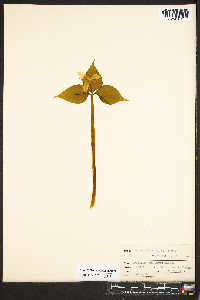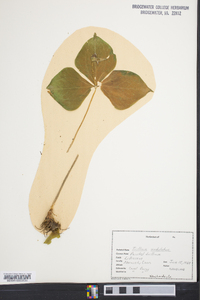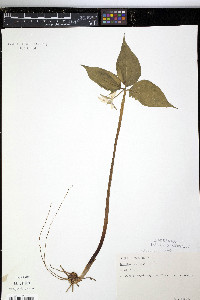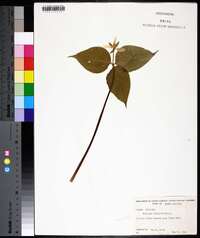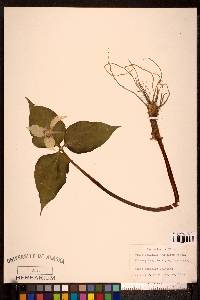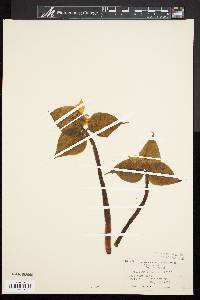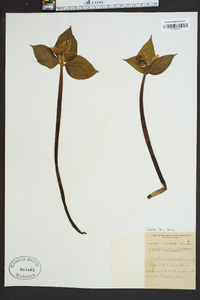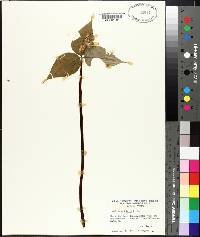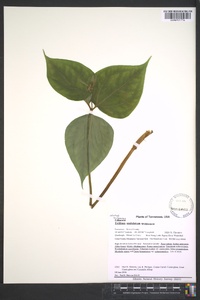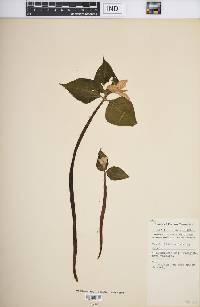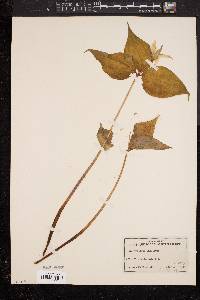
|
|
|
|
Family: Melanthiaceae
Painted Trillium
[Trillidium undulatum (Willd.) Floden & E.E.Schill.] |
Rhizomes horizontal, short, stout, ± praemorse. Scapes 1-3, dark greenish maroon, round in cross section, 1.1-4 dm, glabrous. Bracts strongly petiolate; blade dark green over maroon, main veins prominent, ovate to long-acuminate, 12-18 × 8-20 cm, ± glossy, base above petiole rounded, apex acuminate; petiole 4-17 mm. Flower opening above bracts, erect, odor unknown; sepals conspicuous, spreading, wine red to dull maroon green, rarely white-striated, lanceolate-acuminate, 13-37 × 4-10 mm, margins entire, apex acuminate; petals spreading, white, with distinct, inverted, V-shaped, dark-red mark basally, the red radiating outward along major veins, or white and lacking red marks, veins not engraved, oblong-ovate, occasionally lanceolate, usually widest just above middle, 2-5 × 1-2 cm, base tapering very gradually to attachment, margins not undulate basally, undulate apically, apex somewhat rapidly acuminate; stamens straight, 8-12 mm; filaments pink or white, equaling or longer than anthers, slender; anthers erect or slightly spreading, white or pink, 2-7 mm, thin, dehiscence extrorse; connectives pink, equaling anther sac; ovary fully exposed, white, pink tipped, obtusely 3-angled, becoming obscurely angled-rotund in cross section, 3-10 mm, broadly attached; stigmas ascending, barely connate basally, then strongly recurved, white, ± linear, 3-10 mm, uniformly thin; pedicel erect, 2-5 cm. Fruits quickly deciduous upon ripening, scarlet, obscurely 3-angled to cylindrical, 1-2 cm, fleshy, juicy. 2n = 10. Flowering late spring--early summer (late Apr--Jun). Deep acid humus of pine, spruce, hemlock, oak, mixed deciduous-coniferous woods, rhododendron or mountain laurel thickets in s range, almost any acidic forested situation n and ne, often around old Pinus strobus stumps in white birch-red maple-white pine second-growth woods in n range; prefers deep shade except at high elevations in range; not usually found on limestone-derived or basic soils unless in very deep acid humus; 10--1800 m; N.B., N.S., Ont., P.E.I., Que.; Conn., Ga., Ky., Maine, Md., Mass., Mich., N.H., N.J., N.Y., N.C., Ohio, Pa., R.I., S.C., Tenn., Vt., Va., W.Va. Several forms of Trillium undulatum have been described. One, forma enotatum T. S. Patrick, lacks the usual red, V-shaped petal markings. Other named forms have green petals, extra leaves or petals, and deformities suggesting a mycoplasma infection as in Trillium grandiflorum. This difficult-to-cultivate species has been reported from Wisconsin, but it cannot be accepted as native there.
Perennial herb with a short, stout rhizome stem 11 - 40 cm tall Flowers: single, upright, with six distinct tepals. Flower stalk upright or declined, 2 - 5 cm long. Stamens six, alternating in two whorls of three. Sepals: three, persistent, red to dull maroon-green, 1.3 - 3.7 cm long, 4 - 10 mm wide, shorter than the petals, lance-shaped with a pointed tip, spreading. Petals: three, white, reddish purple at the base (in an inverted V shape), sometimes reddish purple along the major veins, 2 - 5 cm long, 1 - 2 cm wide, oblong to egg-shaped, sometimes lance-shaped, spreading, wavy-edged, shriveling after the flowering period. Fruit: a many-seeded berry, upright, bright red, 1 - 2 cm long, obscurely three-angled to cylindrical, fleshy, juicy. Seeds many, elliptic. Similar species: This Trillium species is easily distinguished from the others by having a white flower with a reddish purple center. Flowering: late April to June Habitat and ecology: Rare in the Chicago Region, known only from Berrien County, Michigan. Found in moist to wet woods and along streams. Occurence in the Chicago region: native Notes: Trilliums do not actually have true leaves or stems above the ground. The underground rhizome produces scale-like leaves called cataphylls. The aboveground leaf-like structures are bracts that subtend the flower, but these are internally and externally similar to leaves and function in photosynthesis. Many authors will refer to them as leaves. Etymology: Trillium comes from the Greek word trilix, meaning triple, referring to how all the plant parts occur in threes. Undulatum means wavy. Author: The Morton Arboretum Stem 2-4 dm at anthesis; lvs ovate, thin, 5-10 cm at anthesis, much larger at maturity, sharply acuminate, broadly rounded to a 5-10 mm petiole; peduncle 2-5 cm, erect or declined; sep lanceolate, shorter than the pet; pet white with a streaky purple crescent near the base, lance-ovate to obovate-oblong, undulate, 2-4 cm, acute or acuminate; filaments very slender, longer than the extrorse anthers; ovary pale, 3-lobed; fr erect, 1.5-2 cm; 2n=10. Moist or wet woods and streambanks; Que. and Ont. to N.J. and Pa., s. in the mts. to Tenn. and Ga., and w. to Mich. and Wis. May, June. Gleason, Henry A. & Cronquist, Arthur J. 1991. Manual of vascular plants of northeastern United States and adjacent Canada. lxxv + 910 pp. ©The New York Botanical Garden. All rights reserved. Used by permission. |

